The Summer Palace, originally named Qingyi Yuan (the Garden of Clear Ripples), is a royal garden from the Qing Dynasty. It is the largest and best-preserved imperial garden in China. With its grand scale, rich architectural diversity, and profound cultural connotations, it is honored as the “Museum of Royal Gardens.”
Summer Palace Facts
- Address: No. 19 Xinjian Gongmen Road, Haidian District, Beijing 100084, China
- Area: 290 hectares (717 acres)
- Age: 261 years (completed in 1764)
- Type: World Heritage Site, Historic Sites, Sights & Landmarks, Royal Garden, Parks
- Best Seasons: Spring / Autumn
- Top Attractions: Kunming Lake, Seventeen-Arch Bridge, Longevity Hill
- Recommended Visiting Time: half a day
- Opening Time: 6 AM to 7 PM
- Ticket Price: 30 RMB. Book the Summer Palace Tickets here.
The Summer Palace is located in Haidian District in the northwest of Beijing, 15 kilometers from the city center. It is one of the most popular attractions in Beijing. The Summer Palace was a summer resort for the emperors of the Qing Dynasty and their royal family members. With its beautiful landscape and exquisite design, it is a model of ancient Chinese gardens and ranks first among the four major classical gardens in China.
Summer Palace History
The history of the Summer Palace carries the rise and fall, glory and disgrace of hundreds of years, bearing witness to the profound changes in Chinese history.
In 1750, the Summer Palace was built to celebrate the birthday of Emperor Qianlong’s mother. It was originally named “Qingyi Garden”.
In 1860, Qingyi Garden was burned down by the British and French forces.
In 1888, Empress Dowager Cixi used naval funds to rebuild it and renamed it the Summer Palace.
In 1900, it was destroyed by the Eight-Nation Alliance and restored in 1902.
In 1914, the Summer Palace was opened to the public.
In 1998, the Summer Palace was listed as a World Heritage Site by UNESCO and is also one of the first national 5A-level tourist attractions in China.
This place used to be the palace and leisure and entertainment place of the Qing Dynasty royal family, and witnessed many important historical events, such as the Reform Movement of 1898 and the imprisonment of Emperor Guangxu. Walking in the Summer Palace, you can feel the weight and vicissitudes of history, as if traveling through time and space and returning to that ancient era.
What to See in Summer Palace
The Summer Palace, a masterpiece of Chinese gardens, divides into three zones: the administrative zone, featuring the solemn Renshou Hall, where Empress Cixi and Emperor Guangxu handled affairs; the living zone, with halls like Leshou, Yulan, and Yiyun for their residence; and the scenic zone around Longevity Hill and Kunming Lake, offering stunning views and historic sites like Foxiang Pavilion and Seventeen-Arch Bridge.
Suzhou Street
Suzhou Street, originally called Wanshou Mai Mai Jie (Longevity Merchants’ Street), was built on the orders of Emperor Qianlong in imitation of a southern Jiangnan waterside town. It was a specially designed water street for emperors and empresses of the Qing dynasty to stroll and enjoy market scenes. The shopkeepers in the street were actually eunuchs and palace maids in disguise, who would begin “business” when the emperor went on a procession.
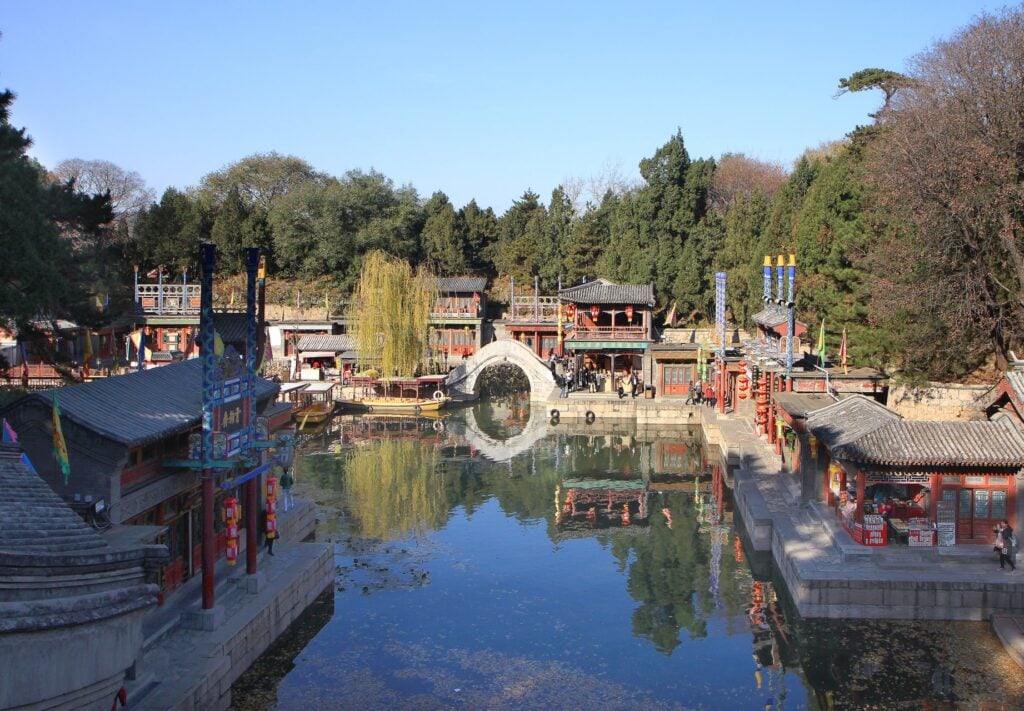
Longevity Hill
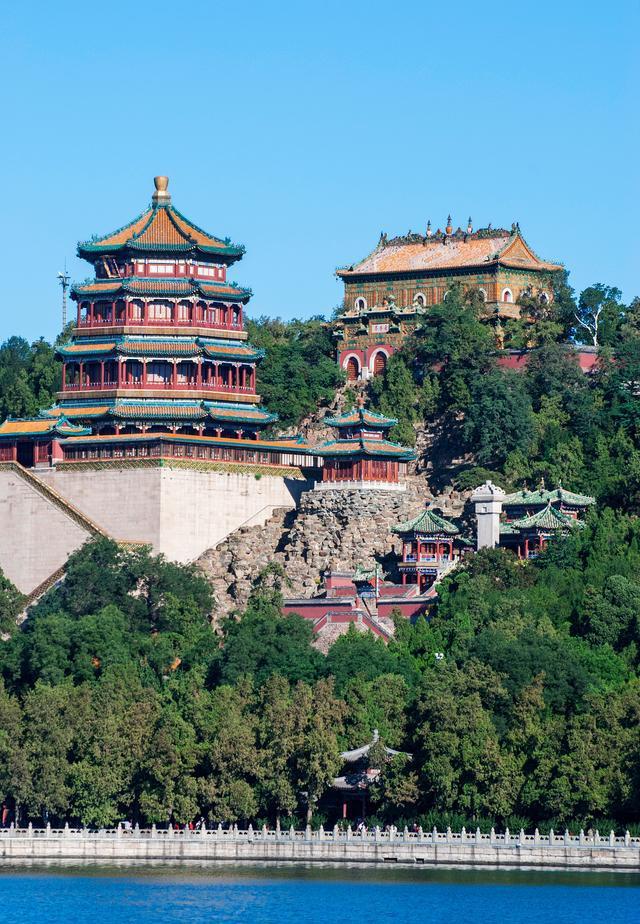
Longevity Hill – This 58-meter-high hill is home to some of the most important buildings in both the front and rear hills of the Summer Palace, including Paiyun Pavilion, Foxiang Pavilion, and several Tibetan Buddhist temples. Among them, Foxiang Pavilion at the summit serves as a landmark of the Summer Palace. From its top, visitors can enjoy a panoramic view of Kunming Lake, and the pavilion looks especially splendid when illuminated at night.
Foxiang Pavilion
Foxiang Pavilion, located on the central hillside of Longevity Hill, is a Buddhist temple built on a 21-meter-high square platform. Standing 41 meters tall, it is an eight-sided, three-story structure with four eaves. The pavilion features eight massive ironwood pillars and complex craftsmanship, making it a masterpiece of classical Chinese architecture. As the highest building in the Summer Palace, it offers a full view of Kunming Lake.
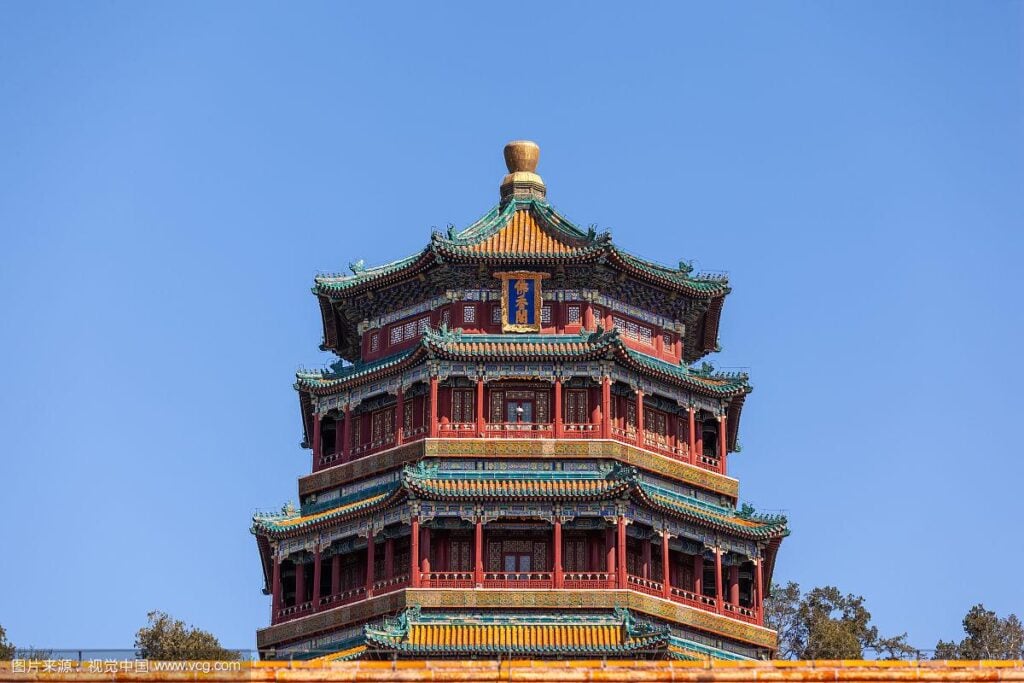
Baoyun Pavilion
Baoyun Pavilion is one of the most exquisite and largest bronze castings in China. It was built on a 4-meter-high white marble base in the Wufang Pavilion courtyard to the west of the Buddhist Incense Pavilion during the Qianlong period. It is 7.5 meters high and weighs 207 tons. There are diamond-shaped fans on all four sides. Although it is made of copper, it is made entirely according to the wooden frame structure. There are doors on the east, south and west sides, with four lattice doors, and eight lattice windows on the north side.
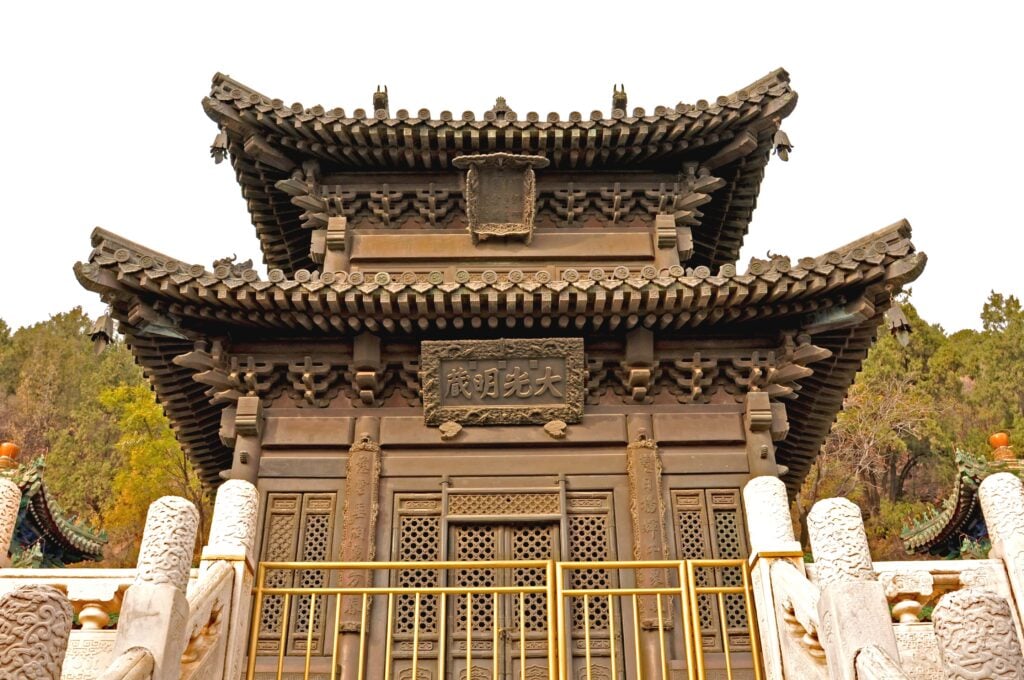
Long Corridor
The Long Corridor, located at the southern foot of Longevity Hill facing Kunming Lake, is the longest garden corridor in China. Stretching 728 meters with 273 sections, it holds the Guinness World Record as the longest corridor of its kind. Over 14,000 colorful paintings decorate its beams, featuring landscapes, flowers, animals, and scenes from Chinese classical literature and folklore.
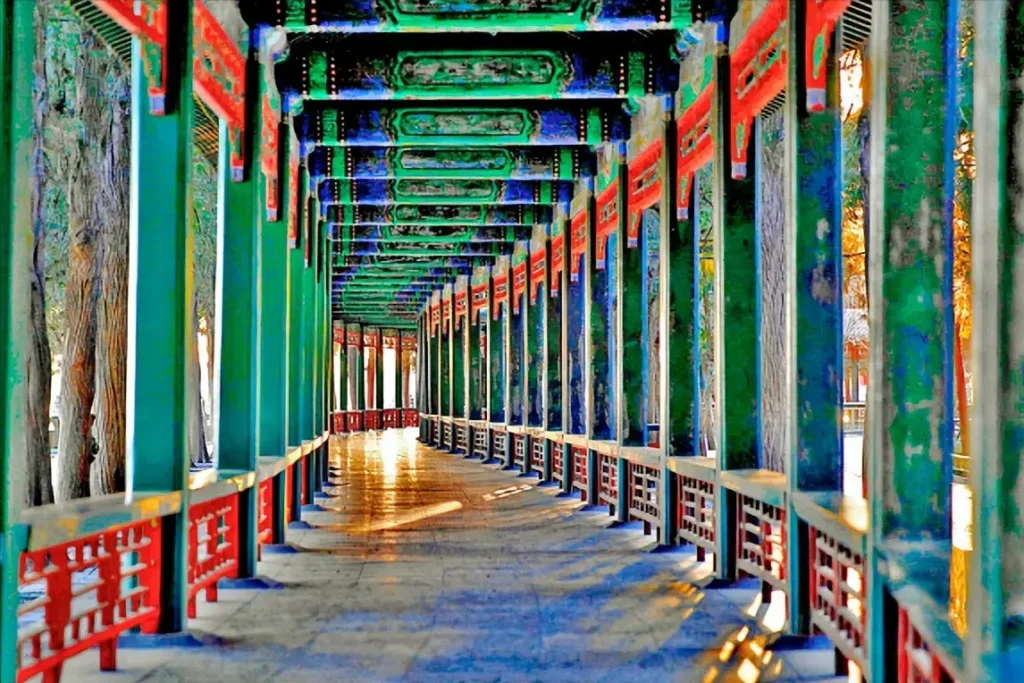
Kunming Lake
Kunming Lake, the main body of water in the Summer Palace, covers over three-quarters of the park’s area, about 220 hectares. It follows the traditional Chinese garden design of “one pool and three mountains,” with three islands representing sacred mountains. Featuring bridges, dykes, and scenic views, it was modeled after West Lake in Hangzhou. The lake has a history of 3,500 years and is surrounded by famous sites like the Seventeen-Arch Bridge and Nanhu Island.
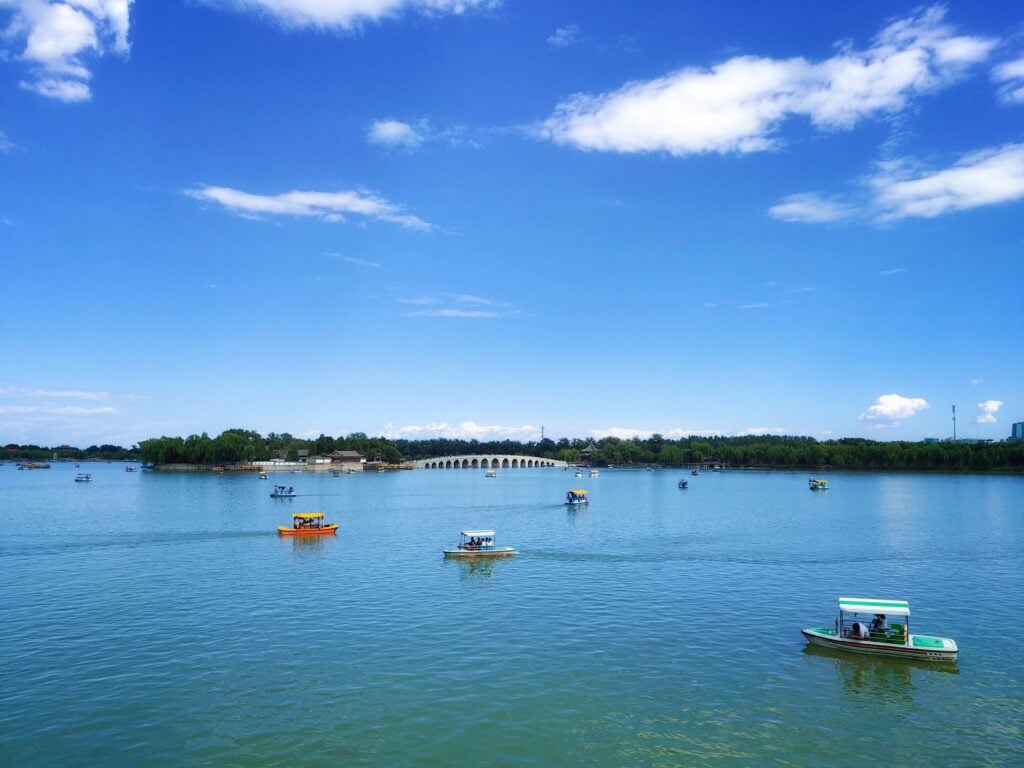
Seventeen-Arch Bridge
Seventeen-Arch Bridge, the largest stone bridge in the Summer Palace, spans 150 meters with 17 arches. It connects the East Causeway to Nanhu Island. The bridge, 8 meters wide, is decorated with over 500 uniquely carved stone lions of different sizes along its railings. Inspired by bridges in Suzhou and Beijing, it is both functional and artistic.
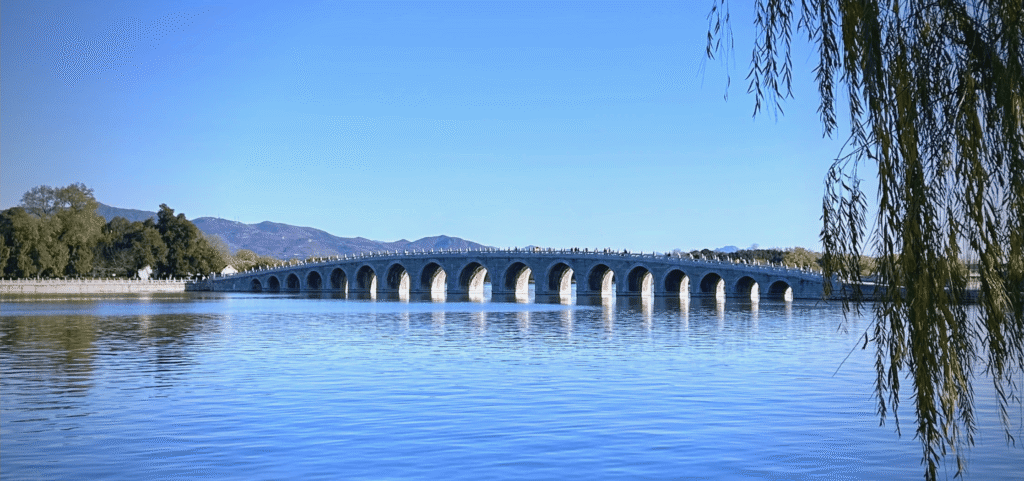
How to get to Summer Palace
By Subway
- Take Line 4 to Xiyuan Station for the East Palace Gate (Exit C2 or D, 10-minute walk).
- Take line 4 to Beigongmen, and exit from D. After that, walk west for 3 minutes to the North Palace Gate.
- For the West Gate, take the Western Suburban Line to Yiheyuanximen Station.
By Bus
- To the East Palace Gate: Take bus 303 and get off at Yiheyuan Station, then walk west for about 200 meters (220 yards) to the gate.
- To the West Gate: Take bus 469, 539 or Zhuan 129 and get off at Yiheyuan Ximen (Yiheyuan West Gate) Station, then walk northeastward for about 300 meters (328 yards) to the gate.
- To the North Palace Gate: Take bus 303, 346, 394, 563, 584 or Sightseeing Line 3 and get off at Yiheyuan Beigongmen (North Palace Gate) Station; or take bus 332, 384, or 601 to Beigongmen Subway Station. The gate is less than 100 meters (109 yards) away.
- To the New Palace Gate: Take bus 74, 374, or 437, and get off at Xin Jian Gong Men (Yiheyuan New Palace Gate) Station.
Summer Palace Tickets Price & Openning Hours
Book tickets with trip discounts| Ticket Type | April to October | November to March |
| Entrance Fee | ¥30 | ¥20 |
| Dehe Garden | ¥5 | ¥5 |
| Tower of Buddhist Incense | ¥10 | ¥10 |
| Summer Palace Museum | ¥20 | ¥20 |
| Suzhou Street and Danning Hall | ¥10 | ¥10 |
| Combo Ticket | ¥60 | ¥50 |
| Openning Hours | 06:00 – 20:00 | 06:30 – 19:00 |
Note:
- Free for children under 1.2 meters (3.9 feet).
- Foreign tourists aged 60 and above can enter the park free of charge with passport verification;
- Opening hours of scenic spots including Tower of Buddhist Incense, Dehe Garden, Summer Palace Museum and Suzhou Street: 08:00 to 17:30 (Apr.-Oct.) and 08:30 to 16:30 (Nov.-Mar.) and are closed on Mondays (except for public holidays).
Recommended Routes
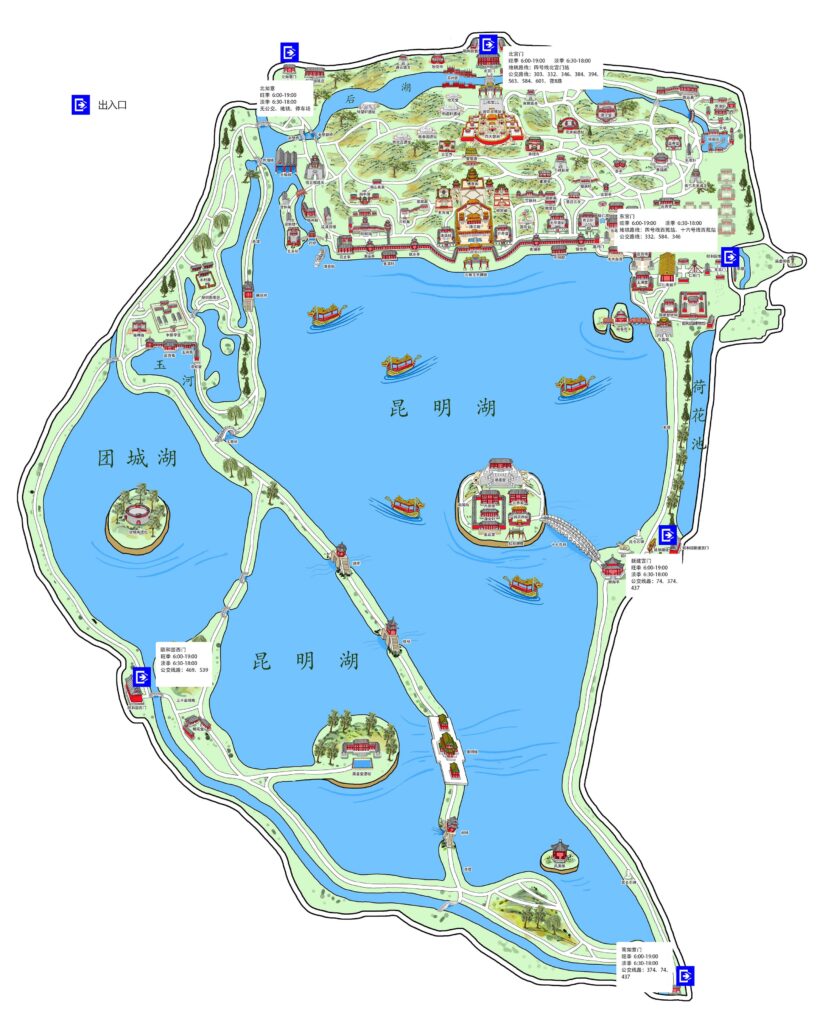
1. 3-5 hours tour route
Entry via North Palace Gate → Suzhou Street → Four Great Regions → Central Axis of Longevity Hill (with Paiyun Pavilion, Foxiang Pavilion, Zhihuihai) → Long Corridor → Huazhongyou → Marble Boat → Boat to Nanhu Island → Seventeen-Arch Bridge → Palace Area (including Renshou Hall, Yulan Hall, Yiyun Hall, Leshou Hall) → Exit via East Palace Gate.
This route is suitable for tourists who have limited time but want to visit the main attractions of the Summer Palace. It allows you to appreciate the essence of the Summer Palace in a short period of time.
2. 3.5 hours tour route
Entry via West Gate → Calm Lake and Green Trees → Southern Lakeside Walk → Scenic South End of Kunming Lake → West Causeway (with Jiehu Bridge, Bin Feng Bridge, Jade Belt Bridge, Jing Bridge, Lian Bridge, Liu Bridge) → Tranquil Path through Longevity Hill → Ancient Temples and Structures → Xiequ Garden (Harmonious Interests Garden) → Exit via North Palace Gate
This route avoids areas where most tourists gather, allowing you to enjoy a peaceful and quiet environment while visiting the Summer Palace and better appreciate the beauty of the gardens.
3. 2 hours tour route
Entry via East Palace Gate → Long Corridor → Marble Boat → Jiehu Bridge → West Causeway → Northern Lakeside Walk → Exit via New Palace Gate
This route is relatively short and easy, suitable for tourists who have limited time or want to take it easy. During the tour, you can stop at any time to rest and enjoy the surrounding beauty according to your own time and physical strength.
Best Time to Visit the Summer Palace
Spring (April-May) is the best time for visiting, with lush willows and blooming flowers everywhere. The garden comes alive, offering picturesque views of nature’s beauty.
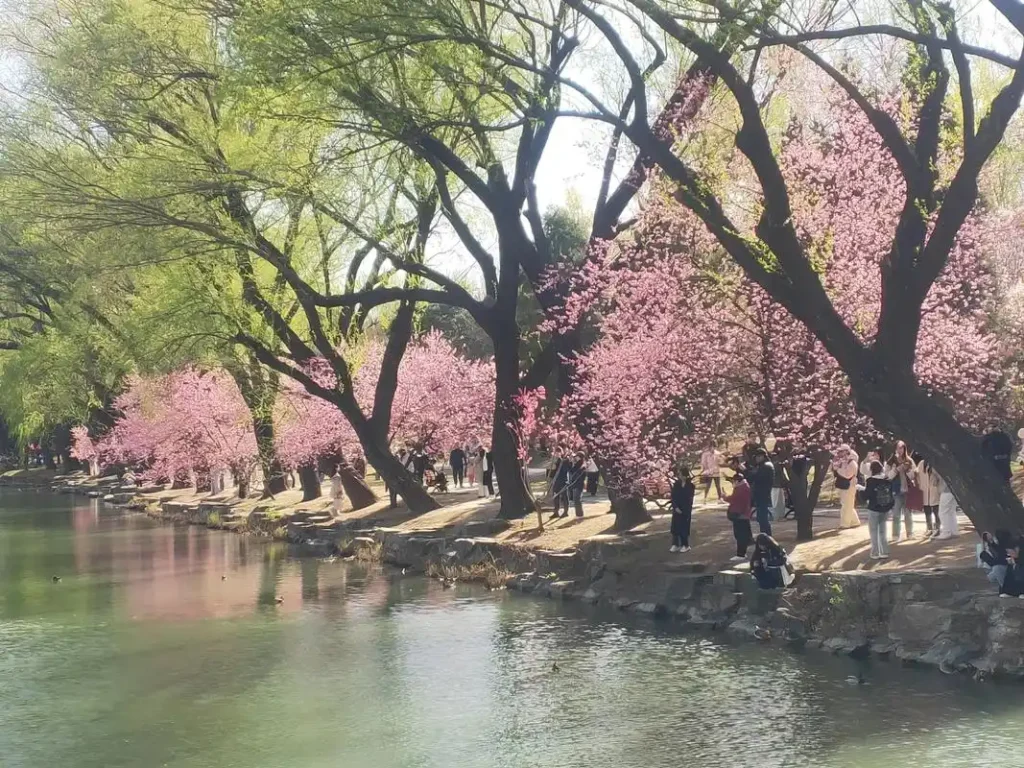
Summer sees lotus blossoms on Kunming Lake, perfect for boating. However, it’s crowded; avoid weekends. Early mornings offer serene experiences and better photo ops.
Autumn (September-October) presents a colorful landscape with fewer tourists. This hidden gem provides a peaceful visit and stunning scenery, ideal for leisurely strolls.
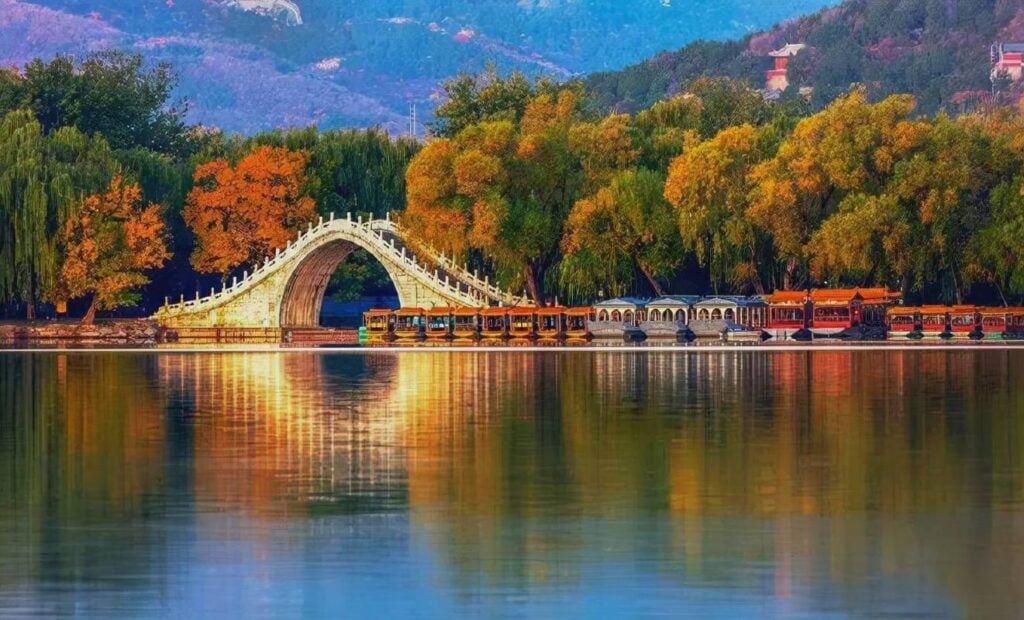
For the best value, visit weekdays from 8 to 10 AM. Fewer crowds and soft lighting make it ideal for photography and enjoying the tranquil ambiance.
Summer Palace FAQs
The Beigong Gate has added a luggage locker, which only costs 10 yuan per day, providing great convenience for tourists.
There are no tour buses, there are boat tours, the cost is 40-70 yuan. But you can rent wheelchairs for the elderly at the entrance.